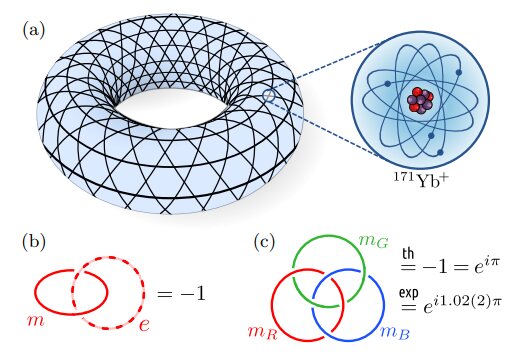In a development that could make quantum computers less prone to errors, a team of physicists from Quantinuum, California Institute of Technology and Harvard University has created a signature of non-Abelian anyons (nonabelions) in a special type of quantum computer. The team has published their results on the arXiv preprint server.
As scientists work to design and build a truly useful quantum computer, one of the difficulties is trying to account for errors that creep in. In this new effort, the researchers have looked to anyons for help.
Anyons are quasiparticles that exist in two dimensions. They are not true particles, but instead exist as vibrations that act like particles—certain groups of them are called nonabelions. Prior research has found that nonabelions have a unique and useful property—they remember some of their own history. This property makes them potentially useful for creating less error-prone quantum computers. But creating, manipulating and doing useful things with them in a quantum computer is challenging. In this new work, the team have come close by creating a physical simulation of nonabelions in action.
The research involved building a quantum computer based on a chip that produces electric fields that can trap ytterbium ions, which are then used to represent qubits. In their design, the trapped ions could be moved around, allowing them to interact if desired. They used this characteristic to entangle 32 ions in a lattice in the form of a kagome, all of which shared the same quantum state. Additional manipulation put the kagome in an excited state that allowed for simulating particles with properties of nonabelions.
The team then tested their machine to ensure the simulated nonabelions performed just as real ones would do under the same conditions—one such test involved moving the nonabelions to create Borromean rings—and that, the team suggests, showed that they might be used to overcome the need for much of the error correction normally involved in quantum computers.
More information:
Mohsin Iqbal et al, Creation of Non-Abelian Topological Order and Anyons on a Trapped-Ion Processor, arXiv (2023). DOI: 10.48550/arxiv.2305.03766
© 2023 Science X Network
Citation:
Nonabelions observed in quantum computer could make them less prone to errors (2023, May 10)
retrieved 10 May 2023
from https://phys.org/news/2023-05-nonabelions-quantum-prone-errors.html
This document is subject to copyright. Apart from any fair dealing for the purpose of private study or research, no
part may be reproduced without the written permission. The content is provided for information purposes only.
Denial of responsibility! TechCodex is an automatic aggregator of the all world’s media. In each content, the hyperlink to the primary source is specified. All trademarks belong to their rightful owners, and all materials to their authors. For any complaint, please reach us at – [email protected]. We will take necessory action within 24 hours.

Jessica Irvine is a tech enthusiast specializing in gadgets. From smart home devices to cutting-edge electronics, Jessica explores the world of consumer tech, offering readers comprehensive reviews, hands-on experiences, and expert insights into the coolest and most innovative gadgets on the market.


